ITECH 2201 Cloud Computing: Detailed Solution of Week 8 Workbook
VerifiedAdded on 2023/06/11
|7
|2060
|453
Homework Assignment
AI Summary
This document provides solutions to the ITECH 2201 Cloud Computing Week 8 workbook, covering topics such as green computing, environmental sustainability, and cloud APIs. It includes explanations of the greenhouse effect, green IT practices, and environmental standards like EPEAT and Energy Star. The document also explores cloud API functionalities with examples from Google, Amazon, and GoGrid, and provides a report on Openstack features and functionalities, including its benefits for portability, security, and resource management. References to research papers and online resources are included to support the answers. Desklib offers this and other solved assignments to aid students in their studies.
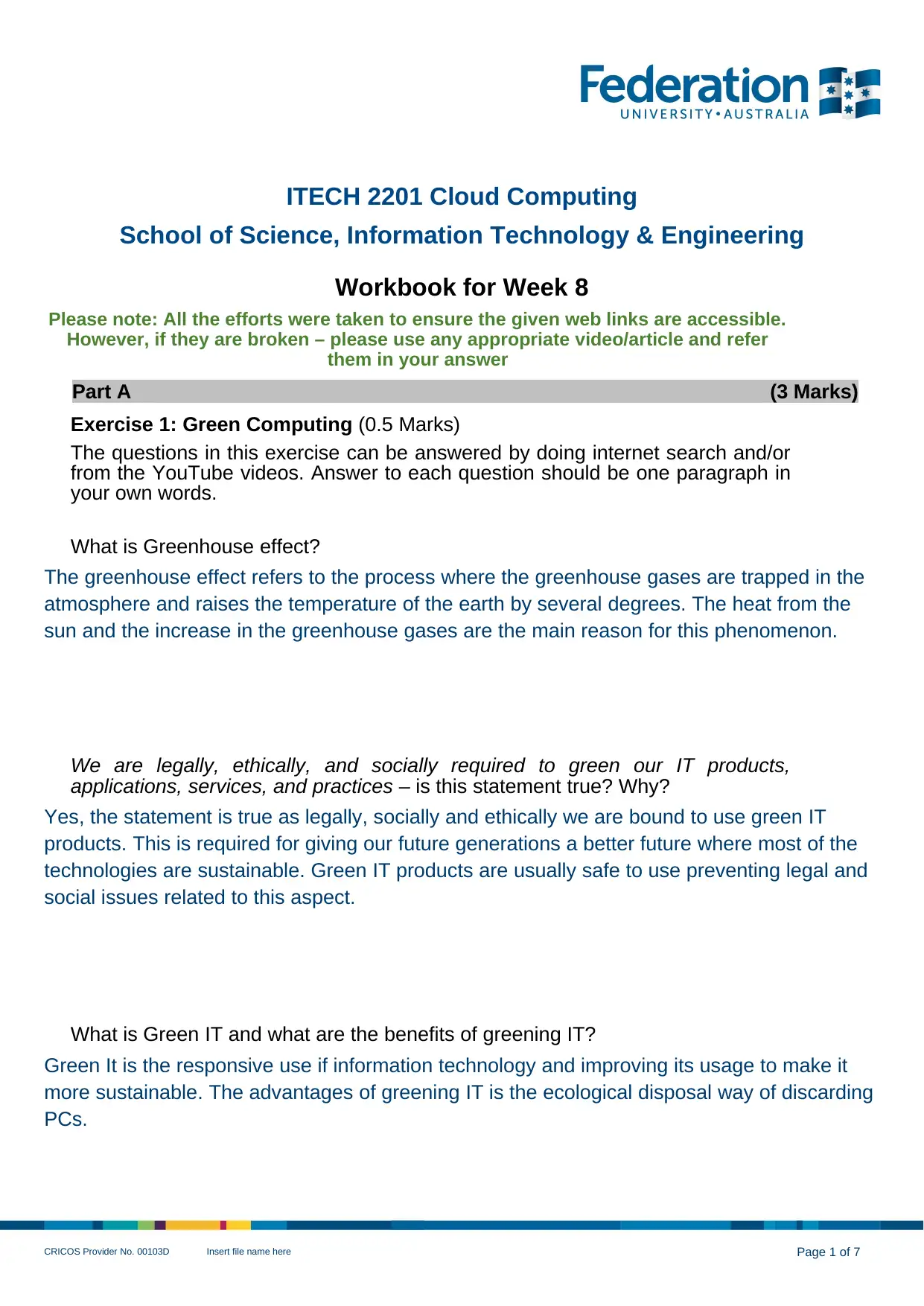
ITECH 2201 Cloud Computing
School of Science, Information Technology & Engineering
Workbook for Week 8
Please note: All the efforts were taken to ensure the given web links are accessible.
However, if they are broken – please use any appropriate video/article and refer
them in your answer
Part A (3 Marks)
Exercise 1: Green Computing (0.5 Marks)
The questions in this exercise can be answered by doing internet search and/or
from the YouTube videos. Answer to each question should be one paragraph in
your own words.
What is Greenhouse effect?
The greenhouse effect refers to the process where the greenhouse gases are trapped in the
atmosphere and raises the temperature of the earth by several degrees. The heat from the
sun and the increase in the greenhouse gases are the main reason for this phenomenon.
We are legally, ethically, and socially required to green our IT products,
applications, services, and practices – is this statement true? Why?
Yes, the statement is true as legally, socially and ethically we are bound to use green IT
products. This is required for giving our future generations a better future where most of the
technologies are sustainable. Green IT products are usually safe to use preventing legal and
social issues related to this aspect.
What is Green IT and what are the benefits of greening IT?
Green It is the responsive use if information technology and improving its usage to make it
more sustainable. The advantages of greening IT is the ecological disposal way of discarding
PCs.
CRICOS Provider No. 00103D Insert file name here Page 1 of 7
School of Science, Information Technology & Engineering
Workbook for Week 8
Please note: All the efforts were taken to ensure the given web links are accessible.
However, if they are broken – please use any appropriate video/article and refer
them in your answer
Part A (3 Marks)
Exercise 1: Green Computing (0.5 Marks)
The questions in this exercise can be answered by doing internet search and/or
from the YouTube videos. Answer to each question should be one paragraph in
your own words.
What is Greenhouse effect?
The greenhouse effect refers to the process where the greenhouse gases are trapped in the
atmosphere and raises the temperature of the earth by several degrees. The heat from the
sun and the increase in the greenhouse gases are the main reason for this phenomenon.
We are legally, ethically, and socially required to green our IT products,
applications, services, and practices – is this statement true? Why?
Yes, the statement is true as legally, socially and ethically we are bound to use green IT
products. This is required for giving our future generations a better future where most of the
technologies are sustainable. Green IT products are usually safe to use preventing legal and
social issues related to this aspect.
What is Green IT and what are the benefits of greening IT?
Green It is the responsive use if information technology and improving its usage to make it
more sustainable. The advantages of greening IT is the ecological disposal way of discarding
PCs.
CRICOS Provider No. 00103D Insert file name here Page 1 of 7
Paraphrase This Document
Need a fresh take? Get an instant paraphrase of this document with our AI Paraphraser
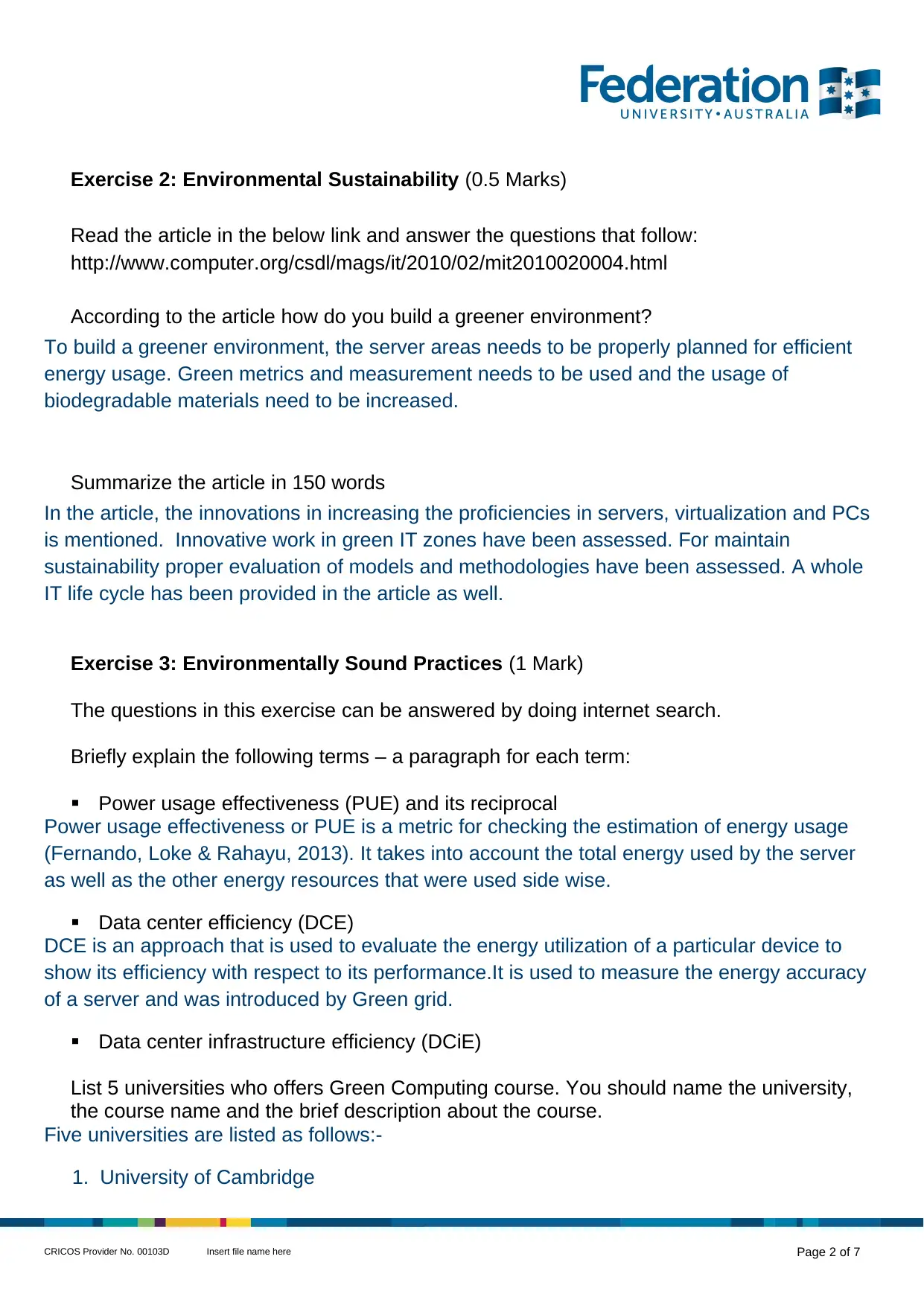
Exercise 2: Environmental Sustainability (0.5 Marks)
Read the article in the below link and answer the questions that follow:
http://www.computer.org/csdl/mags/it/2010/02/mit2010020004.html
According to the article how do you build a greener environment?
To build a greener environment, the server areas needs to be properly planned for efficient
energy usage. Green metrics and measurement needs to be used and the usage of
biodegradable materials need to be increased.
Summarize the article in 150 words
In the article, the innovations in increasing the proficiencies in servers, virtualization and PCs
is mentioned. Innovative work in green IT zones have been assessed. For maintain
sustainability proper evaluation of models and methodologies have been assessed. A whole
IT life cycle has been provided in the article as well.
Exercise 3: Environmentally Sound Practices (1 Mark)
The questions in this exercise can be answered by doing internet search.
Briefly explain the following terms – a paragraph for each term:
Power usage effectiveness (PUE) and its reciprocal
Power usage effectiveness or PUE is a metric for checking the estimation of energy usage
(Fernando, Loke & Rahayu, 2013). It takes into account the total energy used by the server
as well as the other energy resources that were used side wise.
Data center efficiency (DCE)
DCE is an approach that is used to evaluate the energy utilization of a particular device to
show its efficiency with respect to its performance.It is used to measure the energy accuracy
of a server and was introduced by Green grid.
Data center infrastructure efficiency (DCiE)
List 5 universities who offers Green Computing course. You should name the university,
the course name and the brief description about the course.
Five universities are listed as follows:-
1. University of Cambridge
CRICOS Provider No. 00103D Insert file name here Page 2 of 7
Read the article in the below link and answer the questions that follow:
http://www.computer.org/csdl/mags/it/2010/02/mit2010020004.html
According to the article how do you build a greener environment?
To build a greener environment, the server areas needs to be properly planned for efficient
energy usage. Green metrics and measurement needs to be used and the usage of
biodegradable materials need to be increased.
Summarize the article in 150 words
In the article, the innovations in increasing the proficiencies in servers, virtualization and PCs
is mentioned. Innovative work in green IT zones have been assessed. For maintain
sustainability proper evaluation of models and methodologies have been assessed. A whole
IT life cycle has been provided in the article as well.
Exercise 3: Environmentally Sound Practices (1 Mark)
The questions in this exercise can be answered by doing internet search.
Briefly explain the following terms – a paragraph for each term:
Power usage effectiveness (PUE) and its reciprocal
Power usage effectiveness or PUE is a metric for checking the estimation of energy usage
(Fernando, Loke & Rahayu, 2013). It takes into account the total energy used by the server
as well as the other energy resources that were used side wise.
Data center efficiency (DCE)
DCE is an approach that is used to evaluate the energy utilization of a particular device to
show its efficiency with respect to its performance.It is used to measure the energy accuracy
of a server and was introduced by Green grid.
Data center infrastructure efficiency (DCiE)
List 5 universities who offers Green Computing course. You should name the university,
the course name and the brief description about the course.
Five universities are listed as follows:-
1. University of Cambridge
CRICOS Provider No. 00103D Insert file name here Page 2 of 7
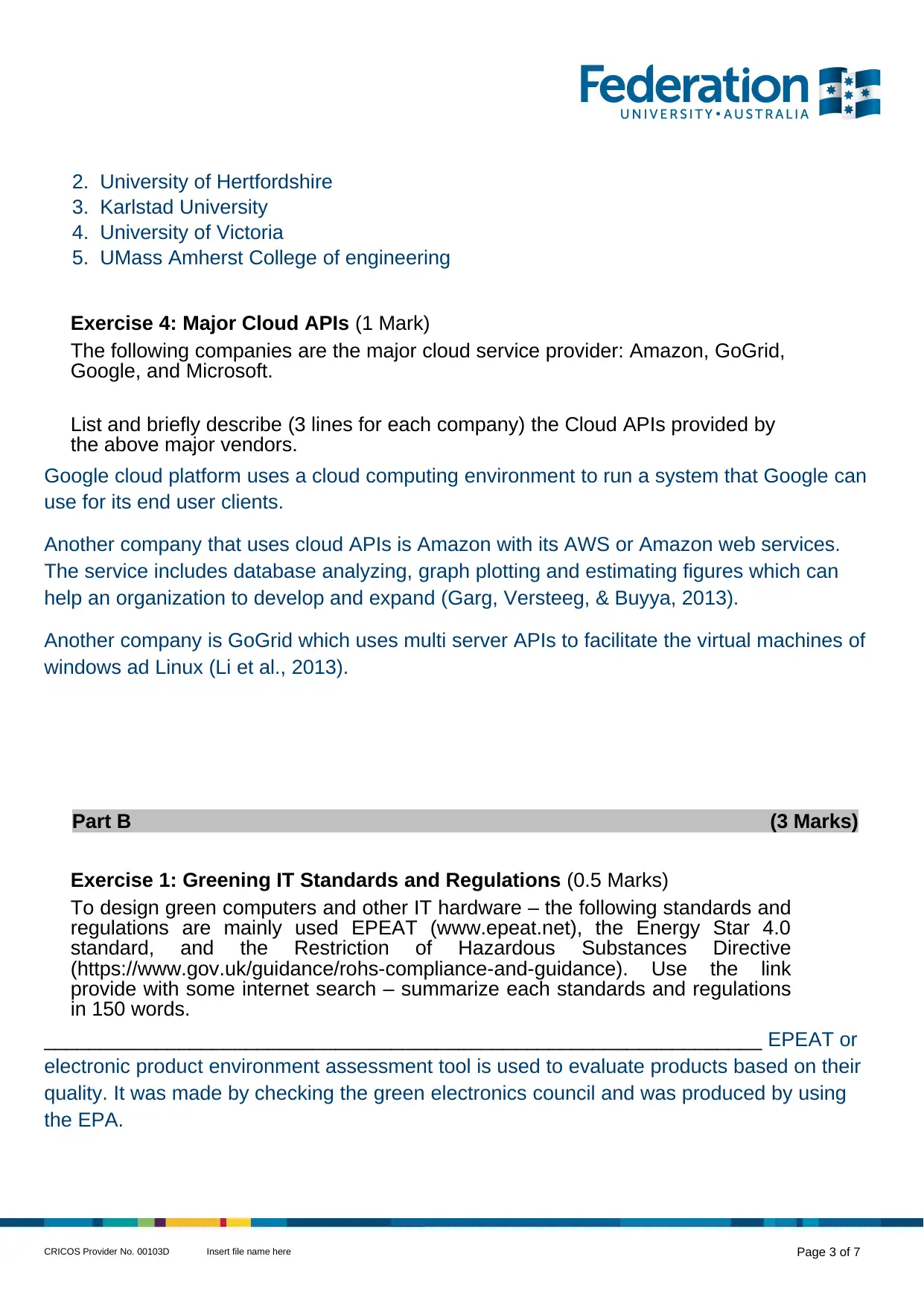
2. University of Hertfordshire
3. Karlstad University
4. University of Victoria
5. UMass Amherst College of engineering
Exercise 4: Major Cloud APIs (1 Mark)
The following companies are the major cloud service provider: Amazon, GoGrid,
Google, and Microsoft.
List and briefly describe (3 lines for each company) the Cloud APIs provided by
the above major vendors.
Google cloud platform uses a cloud computing environment to run a system that Google can
use for its end user clients.
Another company that uses cloud APIs is Amazon with its AWS or Amazon web services.
The service includes database analyzing, graph plotting and estimating figures which can
help an organization to develop and expand (Garg, Versteeg, & Buyya, 2013).
Another company is GoGrid which uses multi server APIs to facilitate the virtual machines of
windows ad Linux (Li et al., 2013).
Part B (3 Marks)
Exercise 1: Greening IT Standards and Regulations (0.5 Marks)
To design green computers and other IT hardware – the following standards and
regulations are mainly used EPEAT (www.epeat.net), the Energy Star 4.0
standard, and the Restriction of Hazardous Substances Directive
(https://www.gov.uk/guidance/rohs-compliance-and-guidance). Use the link
provide with some internet search – summarize each standards and regulations
in 150 words.
________________________________________________________________ EPEAT or
electronic product environment assessment tool is used to evaluate products based on their
quality. It was made by checking the green electronics council and was produced by using
the EPA.
CRICOS Provider No. 00103D Insert file name here Page 3 of 7
3. Karlstad University
4. University of Victoria
5. UMass Amherst College of engineering
Exercise 4: Major Cloud APIs (1 Mark)
The following companies are the major cloud service provider: Amazon, GoGrid,
Google, and Microsoft.
List and briefly describe (3 lines for each company) the Cloud APIs provided by
the above major vendors.
Google cloud platform uses a cloud computing environment to run a system that Google can
use for its end user clients.
Another company that uses cloud APIs is Amazon with its AWS or Amazon web services.
The service includes database analyzing, graph plotting and estimating figures which can
help an organization to develop and expand (Garg, Versteeg, & Buyya, 2013).
Another company is GoGrid which uses multi server APIs to facilitate the virtual machines of
windows ad Linux (Li et al., 2013).
Part B (3 Marks)
Exercise 1: Greening IT Standards and Regulations (0.5 Marks)
To design green computers and other IT hardware – the following standards and
regulations are mainly used EPEAT (www.epeat.net), the Energy Star 4.0
standard, and the Restriction of Hazardous Substances Directive
(https://www.gov.uk/guidance/rohs-compliance-and-guidance). Use the link
provide with some internet search – summarize each standards and regulations
in 150 words.
________________________________________________________________ EPEAT or
electronic product environment assessment tool is used to evaluate products based on their
quality. It was made by checking the green electronics council and was produced by using
the EPA.
CRICOS Provider No. 00103D Insert file name here Page 3 of 7
⊘ This is a preview!⊘
Do you want full access?
Subscribe today to unlock all pages.

Trusted by 1+ million students worldwide
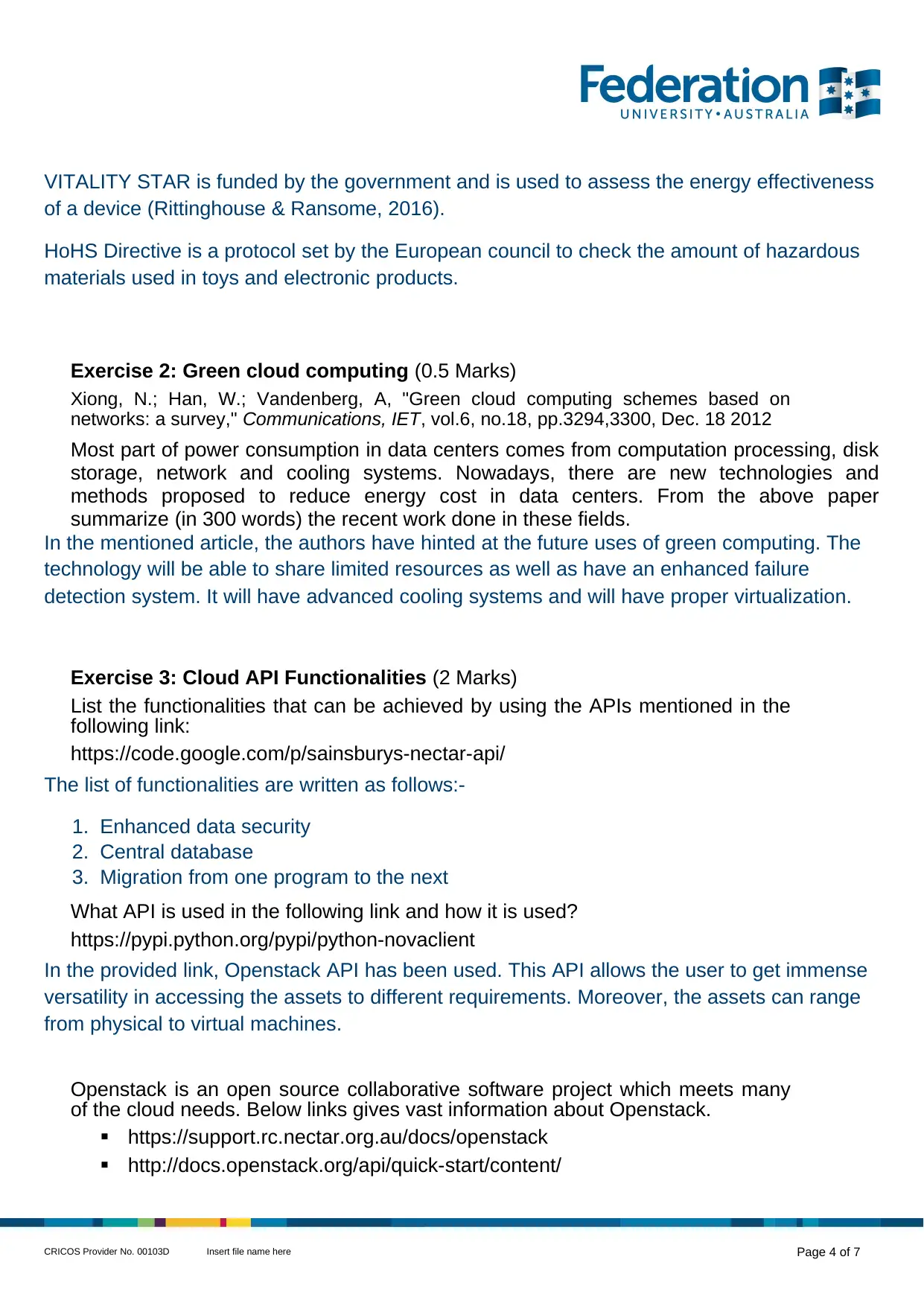
VITALITY STAR is funded by the government and is used to assess the energy effectiveness
of a device (Rittinghouse & Ransome, 2016).
HoHS Directive is a protocol set by the European council to check the amount of hazardous
materials used in toys and electronic products.
Exercise 2: Green cloud computing (0.5 Marks)
Xiong, N.; Han, W.; Vandenberg, A, "Green cloud computing schemes based on
networks: a survey," Communications, IET, vol.6, no.18, pp.3294,3300, Dec. 18 2012
Most part of power consumption in data centers comes from computation processing, disk
storage, network and cooling systems. Nowadays, there are new technologies and
methods proposed to reduce energy cost in data centers. From the above paper
summarize (in 300 words) the recent work done in these fields.
In the mentioned article, the authors have hinted at the future uses of green computing. The
technology will be able to share limited resources as well as have an enhanced failure
detection system. It will have advanced cooling systems and will have proper virtualization.
Exercise 3: Cloud API Functionalities (2 Marks)
List the functionalities that can be achieved by using the APIs mentioned in the
following link:
https://code.google.com/p/sainsburys-nectar-api/
The list of functionalities are written as follows:-
1. Enhanced data security
2. Central database
3. Migration from one program to the next
What API is used in the following link and how it is used?
https://pypi.python.org/pypi/python-novaclient
In the provided link, Openstack API has been used. This API allows the user to get immense
versatility in accessing the assets to different requirements. Moreover, the assets can range
from physical to virtual machines.
Openstack is an open source collaborative software project which meets many
of the cloud needs. Below links gives vast information about Openstack.
https://support.rc.nectar.org.au/docs/openstack
http://docs.openstack.org/api/quick-start/content/
CRICOS Provider No. 00103D Insert file name here Page 4 of 7
of a device (Rittinghouse & Ransome, 2016).
HoHS Directive is a protocol set by the European council to check the amount of hazardous
materials used in toys and electronic products.
Exercise 2: Green cloud computing (0.5 Marks)
Xiong, N.; Han, W.; Vandenberg, A, "Green cloud computing schemes based on
networks: a survey," Communications, IET, vol.6, no.18, pp.3294,3300, Dec. 18 2012
Most part of power consumption in data centers comes from computation processing, disk
storage, network and cooling systems. Nowadays, there are new technologies and
methods proposed to reduce energy cost in data centers. From the above paper
summarize (in 300 words) the recent work done in these fields.
In the mentioned article, the authors have hinted at the future uses of green computing. The
technology will be able to share limited resources as well as have an enhanced failure
detection system. It will have advanced cooling systems and will have proper virtualization.
Exercise 3: Cloud API Functionalities (2 Marks)
List the functionalities that can be achieved by using the APIs mentioned in the
following link:
https://code.google.com/p/sainsburys-nectar-api/
The list of functionalities are written as follows:-
1. Enhanced data security
2. Central database
3. Migration from one program to the next
What API is used in the following link and how it is used?
https://pypi.python.org/pypi/python-novaclient
In the provided link, Openstack API has been used. This API allows the user to get immense
versatility in accessing the assets to different requirements. Moreover, the assets can range
from physical to virtual machines.
Openstack is an open source collaborative software project which meets many
of the cloud needs. Below links gives vast information about Openstack.
https://support.rc.nectar.org.au/docs/openstack
http://docs.openstack.org/api/quick-start/content/
CRICOS Provider No. 00103D Insert file name here Page 4 of 7
Paraphrase This Document
Need a fresh take? Get an instant paraphrase of this document with our AI Paraphraser
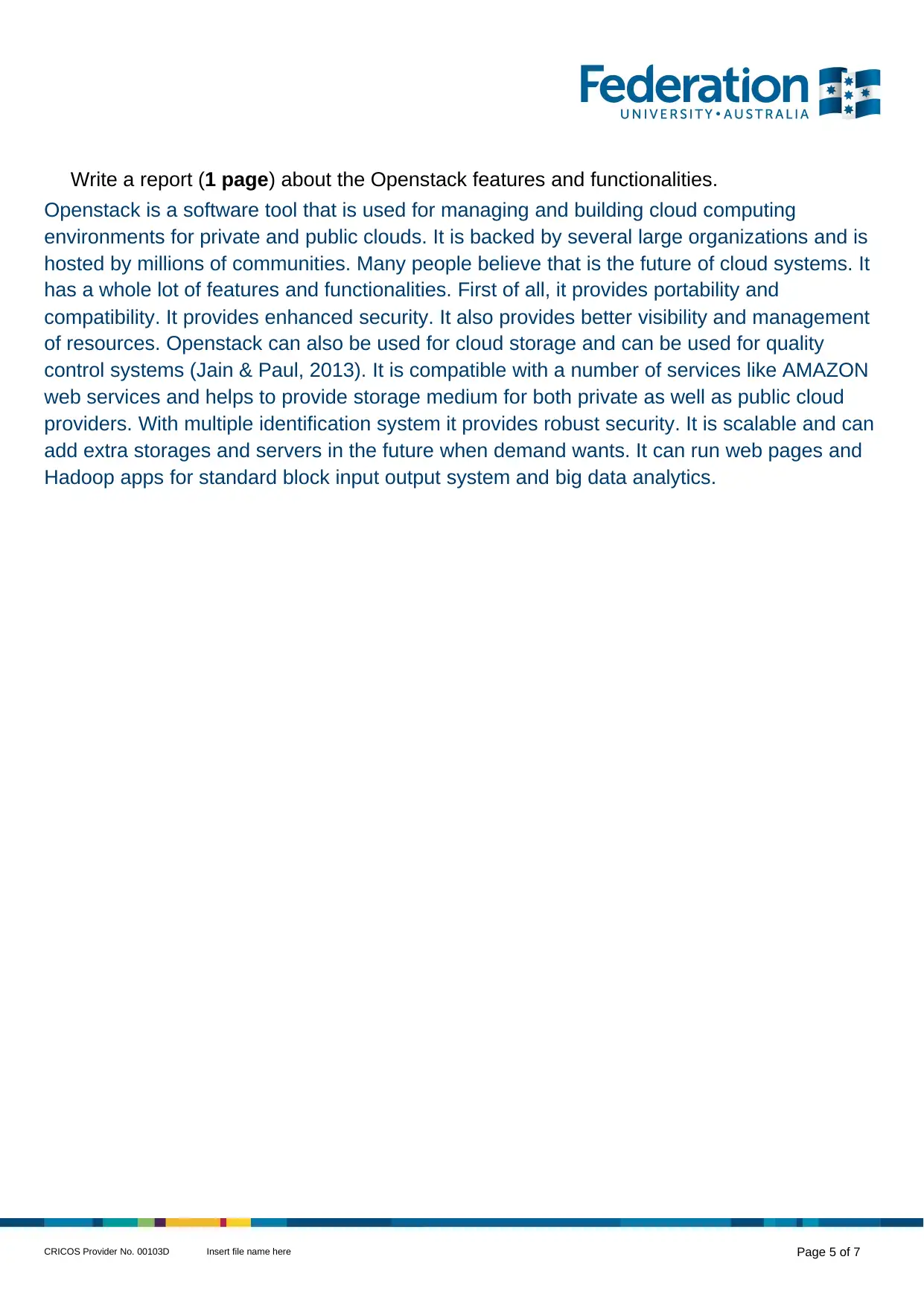
Write a report (1 page) about the Openstack features and functionalities.
Openstack is a software tool that is used for managing and building cloud computing
environments for private and public clouds. It is backed by several large organizations and is
hosted by millions of communities. Many people believe that is the future of cloud systems. It
has a whole lot of features and functionalities. First of all, it provides portability and
compatibility. It provides enhanced security. It also provides better visibility and management
of resources. Openstack can also be used for cloud storage and can be used for quality
control systems (Jain & Paul, 2013). It is compatible with a number of services like AMAZON
web services and helps to provide storage medium for both private as well as public cloud
providers. With multiple identification system it provides robust security. It is scalable and can
add extra storages and servers in the future when demand wants. It can run web pages and
Hadoop apps for standard block input output system and big data analytics.
CRICOS Provider No. 00103D Insert file name here Page 5 of 7
Openstack is a software tool that is used for managing and building cloud computing
environments for private and public clouds. It is backed by several large organizations and is
hosted by millions of communities. Many people believe that is the future of cloud systems. It
has a whole lot of features and functionalities. First of all, it provides portability and
compatibility. It provides enhanced security. It also provides better visibility and management
of resources. Openstack can also be used for cloud storage and can be used for quality
control systems (Jain & Paul, 2013). It is compatible with a number of services like AMAZON
web services and helps to provide storage medium for both private as well as public cloud
providers. With multiple identification system it provides robust security. It is scalable and can
add extra storages and servers in the future when demand wants. It can run web pages and
Hadoop apps for standard block input output system and big data analytics.
CRICOS Provider No. 00103D Insert file name here Page 5 of 7
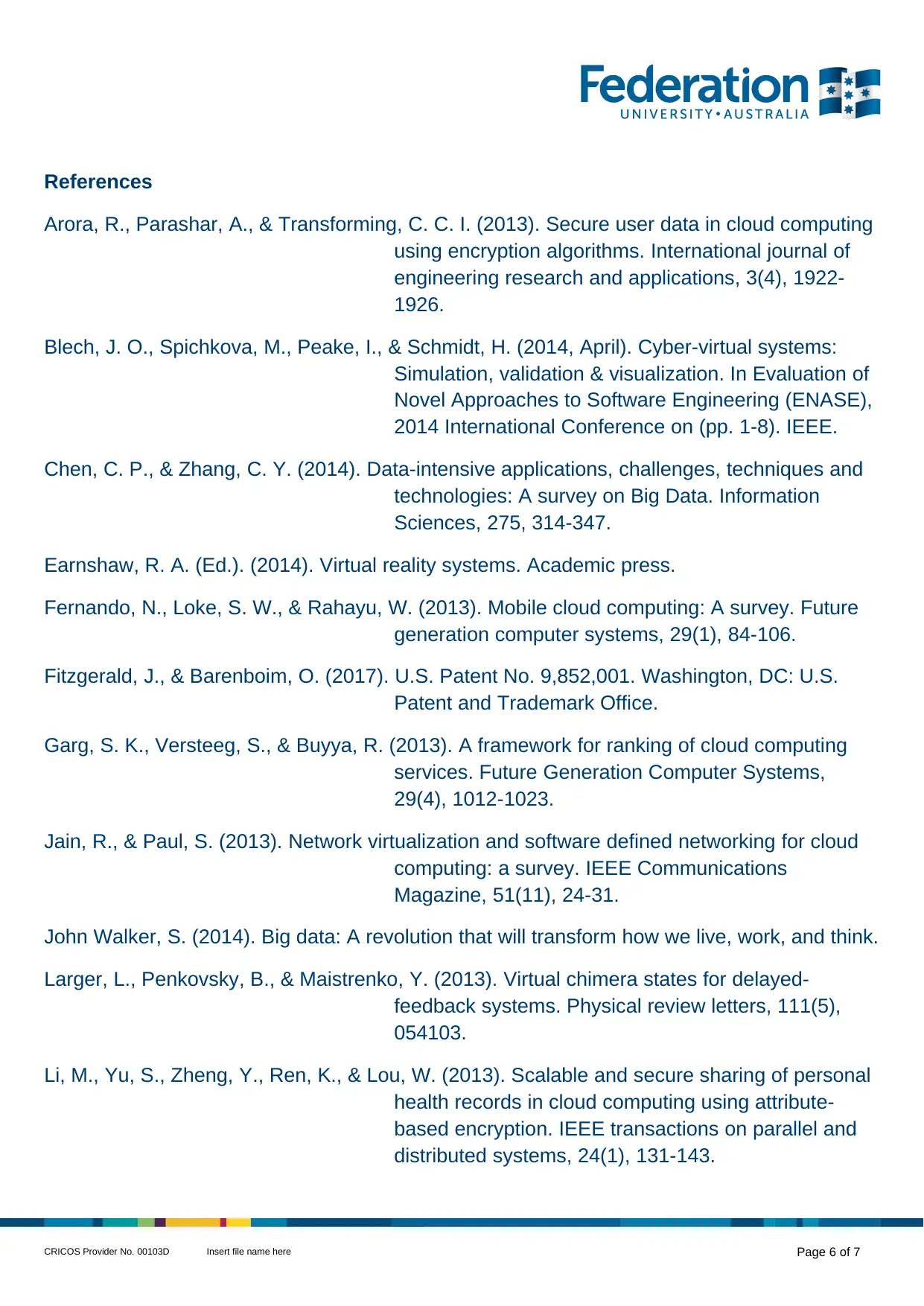
References
Arora, R., Parashar, A., & Transforming, C. C. I. (2013). Secure user data in cloud computing
using encryption algorithms. International journal of
engineering research and applications, 3(4), 1922-
1926.
Blech, J. O., Spichkova, M., Peake, I., & Schmidt, H. (2014, April). Cyber-virtual systems:
Simulation, validation & visualization. In Evaluation of
Novel Approaches to Software Engineering (ENASE),
2014 International Conference on (pp. 1-8). IEEE.
Chen, C. P., & Zhang, C. Y. (2014). Data-intensive applications, challenges, techniques and
technologies: A survey on Big Data. Information
Sciences, 275, 314-347.
Earnshaw, R. A. (Ed.). (2014). Virtual reality systems. Academic press.
Fernando, N., Loke, S. W., & Rahayu, W. (2013). Mobile cloud computing: A survey. Future
generation computer systems, 29(1), 84-106.
Fitzgerald, J., & Barenboim, O. (2017). U.S. Patent No. 9,852,001. Washington, DC: U.S.
Patent and Trademark Office.
Garg, S. K., Versteeg, S., & Buyya, R. (2013). A framework for ranking of cloud computing
services. Future Generation Computer Systems,
29(4), 1012-1023.
Jain, R., & Paul, S. (2013). Network virtualization and software defined networking for cloud
computing: a survey. IEEE Communications
Magazine, 51(11), 24-31.
John Walker, S. (2014). Big data: A revolution that will transform how we live, work, and think.
Larger, L., Penkovsky, B., & Maistrenko, Y. (2013). Virtual chimera states for delayed-
feedback systems. Physical review letters, 111(5),
054103.
Li, M., Yu, S., Zheng, Y., Ren, K., & Lou, W. (2013). Scalable and secure sharing of personal
health records in cloud computing using attribute-
based encryption. IEEE transactions on parallel and
distributed systems, 24(1), 131-143.
CRICOS Provider No. 00103D Insert file name here Page 6 of 7
Arora, R., Parashar, A., & Transforming, C. C. I. (2013). Secure user data in cloud computing
using encryption algorithms. International journal of
engineering research and applications, 3(4), 1922-
1926.
Blech, J. O., Spichkova, M., Peake, I., & Schmidt, H. (2014, April). Cyber-virtual systems:
Simulation, validation & visualization. In Evaluation of
Novel Approaches to Software Engineering (ENASE),
2014 International Conference on (pp. 1-8). IEEE.
Chen, C. P., & Zhang, C. Y. (2014). Data-intensive applications, challenges, techniques and
technologies: A survey on Big Data. Information
Sciences, 275, 314-347.
Earnshaw, R. A. (Ed.). (2014). Virtual reality systems. Academic press.
Fernando, N., Loke, S. W., & Rahayu, W. (2013). Mobile cloud computing: A survey. Future
generation computer systems, 29(1), 84-106.
Fitzgerald, J., & Barenboim, O. (2017). U.S. Patent No. 9,852,001. Washington, DC: U.S.
Patent and Trademark Office.
Garg, S. K., Versteeg, S., & Buyya, R. (2013). A framework for ranking of cloud computing
services. Future Generation Computer Systems,
29(4), 1012-1023.
Jain, R., & Paul, S. (2013). Network virtualization and software defined networking for cloud
computing: a survey. IEEE Communications
Magazine, 51(11), 24-31.
John Walker, S. (2014). Big data: A revolution that will transform how we live, work, and think.
Larger, L., Penkovsky, B., & Maistrenko, Y. (2013). Virtual chimera states for delayed-
feedback systems. Physical review letters, 111(5),
054103.
Li, M., Yu, S., Zheng, Y., Ren, K., & Lou, W. (2013). Scalable and secure sharing of personal
health records in cloud computing using attribute-
based encryption. IEEE transactions on parallel and
distributed systems, 24(1), 131-143.
CRICOS Provider No. 00103D Insert file name here Page 6 of 7
⊘ This is a preview!⊘
Do you want full access?
Subscribe today to unlock all pages.

Trusted by 1+ million students worldwide
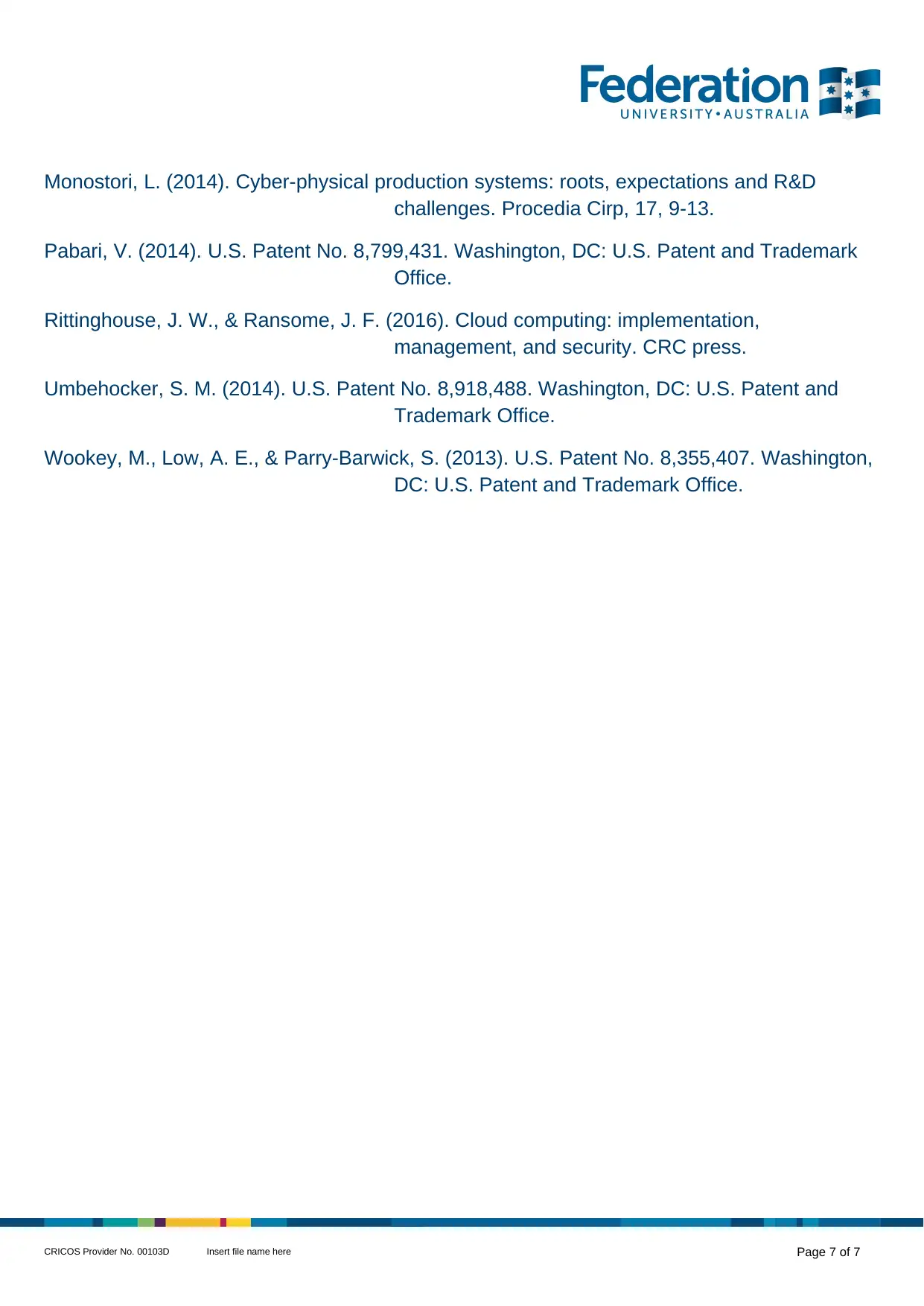
Monostori, L. (2014). Cyber-physical production systems: roots, expectations and R&D
challenges. Procedia Cirp, 17, 9-13.
Pabari, V. (2014). U.S. Patent No. 8,799,431. Washington, DC: U.S. Patent and Trademark
Office.
Rittinghouse, J. W., & Ransome, J. F. (2016). Cloud computing: implementation,
management, and security. CRC press.
Umbehocker, S. M. (2014). U.S. Patent No. 8,918,488. Washington, DC: U.S. Patent and
Trademark Office.
Wookey, M., Low, A. E., & Parry-Barwick, S. (2013). U.S. Patent No. 8,355,407. Washington,
DC: U.S. Patent and Trademark Office.
CRICOS Provider No. 00103D Insert file name here Page 7 of 7
challenges. Procedia Cirp, 17, 9-13.
Pabari, V. (2014). U.S. Patent No. 8,799,431. Washington, DC: U.S. Patent and Trademark
Office.
Rittinghouse, J. W., & Ransome, J. F. (2016). Cloud computing: implementation,
management, and security. CRC press.
Umbehocker, S. M. (2014). U.S. Patent No. 8,918,488. Washington, DC: U.S. Patent and
Trademark Office.
Wookey, M., Low, A. E., & Parry-Barwick, S. (2013). U.S. Patent No. 8,355,407. Washington,
DC: U.S. Patent and Trademark Office.
CRICOS Provider No. 00103D Insert file name here Page 7 of 7
1 out of 7
Your All-in-One AI-Powered Toolkit for Academic Success.
+13062052269
info@desklib.com
Available 24*7 on WhatsApp / Email
![[object Object]](/_next/static/media/star-bottom.7253800d.svg)
Unlock your academic potential
Copyright © 2020–2025 A2Z Services. All Rights Reserved. Developed and managed by ZUCOL.
